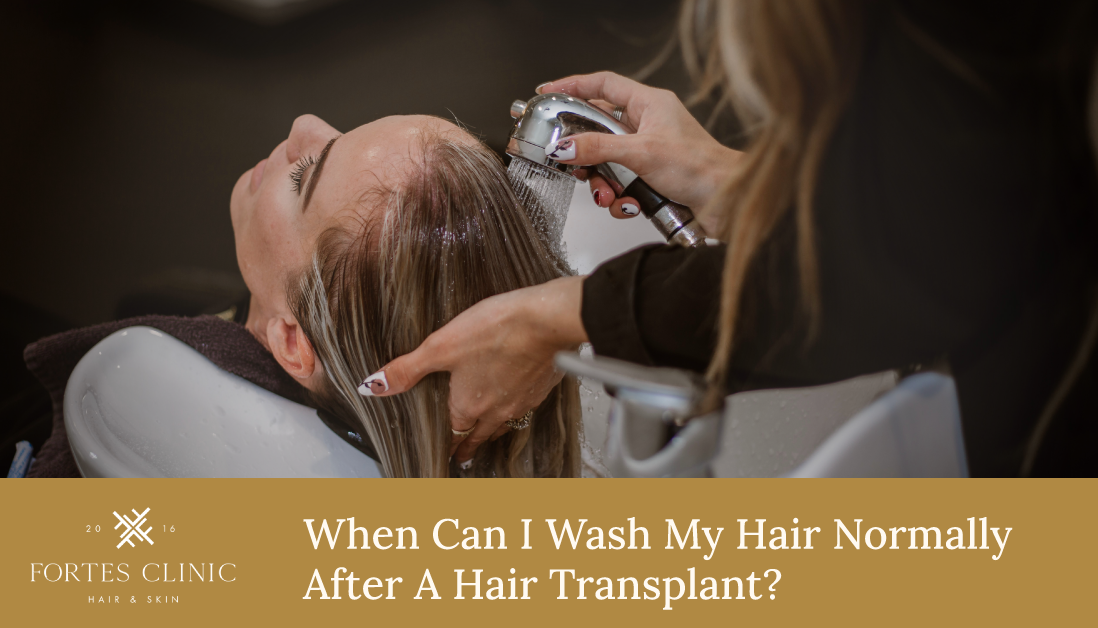Quick answer first
Patients often ask, “When can I wash my hair normally after a hair transplant?” Most people can return to a near-normal wash by day 10 to day 14, once grafts have anchored and scabs have lifted. The first week needs extra care, with gentle soaking, light shampoo, and no rubbing. Your exact timing can vary with healing speed, graft numbers, and the technique used. For a broader view of recovery milestones, see the hair transplant recovery timeline.
Why washing matters after surgery
Clean, careful washing helps remove dried serum and flakes, keeps follicles clear, and reduces itching. Done too roughly, it can disturb grafts early on. A simple plan prevents worry and lets you get back to routine at the right pace.
Day-by-day washing guide (typical plan)
Every clinic gives tailored advice. The outline below shows common practice; follow your own instructions if they differ.
Days 0–2
Rest. Keep the scalp dry unless you were told to gently mist with sterile water or saline. No showers on the grafted area. If advised, you may lightly cleanse the donor area only.
Days 2–3 to Day 5
Start gentle soaking of the recipient area. Let lukewarm water run over the scalp using a cup or low-pressure shower held high above the head. Apply a diluted, mild shampoo to the palm, tap it over the grafts, wait a minute, then rinse with gravity. No rubbing, no nails, no direct jet.
Days 5–7
Continue daily soaks. Soften scabs by layering diluted shampoo or a recommended emollient before rinsing. Allow them to loosen on their own. Pat dry with a soft towel; do not rub. If you must use a dryer, choose a cool setting.
Days 8–10
Most scabs are loosening. Pressure can increase slightly, but avoid scrubbing. If scabs remain, repeat soak-and-soften steps. Many patients can use a gentle fingertip swirl by day 9 or 10, not nails.
Days 10–14
Grafts are typically secure. Many people can wash almost normally now: regular shower stream, mild shampoo, light fingertip massage. If any scabs persist, keep the technique gentle until the skin is clear.
After 14 days
You can usually wash normally. Build up to your usual routine, products, and water pressure over a few days. If the scalp still feels tender, go slower.
For headwear timing alongside washing, see how long after a hair transplant can I wear a hat?
Technique: how to wash without worry
- Water temperature: lukewarm. Hot water increases redness and dryness.
- Water pressure: low at first. Hold the shower high so water falls rather than blasts.
- Shampoo choice: a mild, fragrance-light option is best early on. Medicated products should be clinician-approved.
- Application: lather in your hands, then tap or glide over the scalp. Early on, no circular rubbing.
- Rinse: Let gravity do most of the work.
- Drying: pat with a soft towel. If using a dryer, keep to a cool setting and hold it at a distance.
Donor area vs recipient area
- Recipient area (where grafts were placed): treat gently until day 10–14.
- Donor area (where hair was taken): usually tolerates earlier, gentle washing. If you had FUE, tiny dot sites heal quickly. If you had FUT, follow wound-care advice around the suture line and avoid tension until cleared. Read more about techniques here: FUE hair transplant and FUT hair transplant.
Common mistakes to avoid
- Rubbing or scratching in the first week.
- Power showers aimed directly at grafts too soon.
- Nails instead of soft fingertips.
- Very hot water or steam rooms in the early phase.
- Dry shampoos or heavy styling products before day 10–14.
- Swimming in pools or the sea before you’re cleared. Chlorine, salt, and pressure can irritate healing skin.
What “normal washing” looks like at two weeks
By day 14, most patients can:
- Stand under a regular shower stream.
- Use a normal amount of shampoo and a light conditioner.
- Gently massage with fingertips across both donor and recipient areas.
- Rinse as usual and towel-dry with a patting motion.
If you prefer to go slower, keep the gentler method for a few extra days. Healing speeds differ from person to person.
Itching, flaking, and scabs: what’s normal
Mild itching is common as the skin heals. Flakes and small scabs should lift without force over days 5–10 as you soak and rinse. A few pink spots may remain after scabs fall; they fade with time. If scabs are still widespread after day 12, continue gentle soaks and ask for advice at your check-in.
Product questions people ask
- Conditioner: fine to reintroduce after day 10–14, used lightly.
- Hair masks or oils: wait until the skin feels calm and clear. Start small and see how your scalp reacts.
- Medicated shampoos: only if your clinician recommends them.
- Styling products: Avoid heavy waxes early on. A light mousse or cream is usually safer in week two.
Exercise, sweat, and showers
Light walking is usually fine early, but hard training increases sweat, salt, and friction. If you exercise, rinse gently soon after and keep technique careful until the two-week mark. Avoid hot yoga and saunas in the first fortnight.
What if you see hair shedding in the shower?
Shedding of the transplanted shafts can start around weeks 2–6. This is normal and not a sign the follicle is lost. The root remains and re-growth follows in the months ahead. For a sense of the bigger picture, see the recovery timeline.
When to ask for help
Reach out if you notice:
- Persistent or increasing redness after the first week.
- Pus, spreading warmth, or marked tenderness.
- Thick, stuck scabs that do not lift despite careful soaking by day 12–14.
- Suddenly, painful swelling or anything that feels out of the ordinary.
A quick review can adjust your plan and keep recovery on track. If you need tailored guidance, send photos or arrange a chat via the contact page.
FAQs
When can I wash my hair normally after a hair transplant?
Most people return to a near-normal wash by day 10–14. Go gently until scabs have lifted and the scalp feels calm.
Can I shower on day one?
Not over the grafted area. Many plans begin with gentle soaks from day 2–3. Follow your specific instructions.
How hard can I massage at two weeks?
Light fingertip massage is fine for most patients. If the scalp still feels tight or scabby, ease off and try again in two days.
Does FUE or FUT change the timing?
The recipient area timeline is similar, but the donor area care differs. FUE heals via tiny dots. FUT has a suture line that needs protection from tension while it settles. See: FUE and FUT.
When can I use my regular shampoo?
Often by day 10–14. If it is strongly fragranced or medicated, reintroduce it slowly.
What about wearing a hat after washing?
Use a loose-fitting option only when cleared. Get details here: how long after a hair transplant can I wear a hat?
Summary
In practical terms, the answer to “when can I wash my hair normally after a hair transplant” is about two weeks for most people, with a gentle ramp-up after day 10. Early washing is about soaking, soft shampoo, and patience. Keep hands light, avoid pressure, and let scabs lift on their own. If something does not look right, ask for advice rather than guessing.



